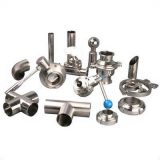When the internal pressure of the gas ballast valve is lower than the external pressure of it, the gas ballast valve is opened, and the gas enters the pump chamber so that the internal pressure of the condensable gas in the pump chamber reaches the saturated vapor pressure, and the pressure of the compressed gas has reached the discharge pressure, the condensable gas is discharged. When the internal pressure of the gas ballast valve is higher than the external pressure of it, the gas ballast valve is closed.
Another effect of gas ballast valve is to restore the ultimate pressure of the vacuum pump. Although sometimes we use sanitary valves to pump out air, it contains little condensable gas, usually the gas ballast valve is closed. But after a long period of time, the oil substance is gradually contaminated by the small amount of condensable gas in the air. For vacuum pumps without gas ballast mechanism, we can only replenish oil, or heat up the pump oil so that liquefied steam gets evaporated in order to restore the original ultimate pressure of the pump. But for vacuum pumps with gas ballast valve, it only takes 1 to 2 hours for the vacuum pump to restore its ultimate pressure.



Recent Comments